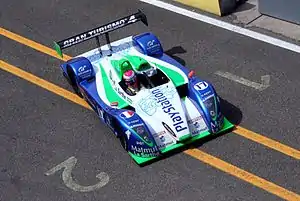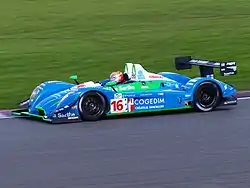Pescarolo Sport
Pescarolo Sport was a motorsport team based in Le Mans, France and founded in February 2000 by French racing driver Henri Pescarolo and his friend and partner, French publisher François Granet. They raced in the Le Mans Series and the 24 Hours of Le Mans. In October 2007, Henri Pescarolo purchased Jacques Nicolet's Saulnier Racing and created Pescarolo Automobiles,[1] with the racing team becoming a division of the new company. The Pescarolo Automobiles went into receivership on 15 June 2010. Following a liquidation sale, the company was resold back to Henri Pescarolo and rebranded as Pescarolo Team for the 2011 season. However, the team's financial situation did not improve, and was wound up in January 2013.

Racing history
Although Henri Pescarolo had been racing, and winning, at Le Mans for many decades, he had always been driving for other teams. From 1994 to 1998, Pescarolo had been driving for the Courage Compétition squad with some success, but decided in 1999 that he would like to run his own team for the 24 Hours of Le Mans, although he would remain connected to Courage and would be a customer team of the factory's chassis. The team was initially known as the Pescarolo Promotion Racing Team, and would take a well-deserved ninth-place finish.
Following this success, Pescarolo decided that he would retire from racing as a driver, but remain in sports car racing as a team owner. On January 1, 2000, Pescarolo Sport was founded in the town of Le Mans, within the grounds of the Circuit de la Sarthe and near Courage Compétition's headquarters. Pescarolo remained close to Courage, using their C52 chassis, as well as reaching an agreement with Peugeot to supply new turbocharged engines. The team initially concentrated on the Le Mans 24 Hours, although they would also make an appearance at the American Le Mans Series event at Silverstone Circuit. In their first run at Le Mans, the team managed an impressive fourth-place finish for drivers Sébastien Bourdais, Olivier Grouillard, and Emmanuel Clerico, made even more impressive by the fact that the top three finishers were all from the factory Audi team.
With this success, Pescarolo Sport expanded vastly for the 2001 season, purchasing two new Courage C60 chassis (chassis numbers 03 and 04) for use in various races of the American Le Mans Series, European Le Mans Series, FIA Sportscar Championship, as well as the usual entry at Le Mans. Unfortunately the team saw their worst effort ever at Le Mans, with only a single car managing to finish in a distant 13th place. However this trouble was soon reversed in July of that year, when Pescarolo recorded their first win at the 1000km of Estoril, followed two weeks later by a win in front of a home crowd at Magny-Cours for the FIA Sportscar Championship, beating the likes of Ferrari 333 SP, Dome-Judd S101 and Ascari-Judd A410.
For 2002, Pescarolo Sport settled on running a full season of the FIA Sportscar Championship, and were able to continue on from their first two wins. The team took two more victories over the course of the season, clinching second place in the teams championship behind Racing for Holland. At Le Mans though, the team did not improve much, recording only a tenth-place finish for their one finishing car.
Moving to 2003, the team unfortunately suffered major difficulties. Running in the FIA Sportscar Championship again, the team started the season with a win, but suffered three straight failures to finish in the following races. Although they would win once more, the team had to settle for once again being a runner-up to Racing for Holland in the teams championship. Le Mans saw some improvement, with both car finishing and taking eighth and ninth place, however Pescarolo began to suffer financial woes. Even though the team managed to take second place at the unique 1000km of Le Mans at the end of the year, Peugeot announced their discontinuation of supplying engines to the team, also leading to the loss of sponsorship money.

With the aid of investment from Sony and promotion of their PlayStation 2 as well as Gran Turismo 4, Pescarolo were able to find the money to purchase new Judd GV5 V10s, as well beginning their first work in engineering. Feeling the Courage C60s were not perfect, Pescarolo Sport began development of new bodywork and mechanical elements in order to increase the cars performance. For the 2004 the cars were renamed as Pescarolo C60s, due to the vast differences between them at standard Courage produced cars.
Although still strapped for cash, the team began a one car effort in the new Le Mans Endurance Series due to the FIA Sportscar Championship folding at the end of 2003. Managing to earn points in the first two races of the season, the team finished the year tied for sixth in the championship. At Le Mans however, the team managed to regain some of their past success, with their sole finishing car taking fourth place behind a trio of Audis but also finishing ahead of a fourth Audi.
2005 saw Pescarolo improve rapidly, with the team winning two rounds of the Le Mans Endurance Series season. These wins helped Pescarolo Sport earn their first championship, earning it by a mere two points. This success continued at Le Mans, with Pescarolo earning their best finish ever, a second place behind an Audi, separated by a just two laps, and also making the fastest lap of the race. Pescarolo had been backed heavily to cause an upset and trump the dominant Audis, especially after taking pole position.[2]
Pescarolo Sport finally become a dominant, front-running team in 2006. In the Le Mans Series, Pescarolo out performed the competition and were able to sweep the entire season, winning all five races and easily defending their championship title. At Le Mans, the team also repeated their previous success by taking another second place, this time behind the new Audi R10 diesel, although the team did manage to finish ahead of the other R10.
Pescarolo 01
Following the end of the 2006 season, Pescarolo Sport announced their plans to develop their own, all-new chassis for 2007 in order to comply with new Le Mans Prototype regulations. The new cars, known as Pescarolo 01s, would use a brand-new chassis and bodywork evolved from the previous Pescarolo C60s. However, for the first time, Pescarolo would become a supplier, offering the 01s for sale to customer teams not only in the top LMP1 class, but also in the smaller LMP2 class.

Following on from two for Pescarolo Sport, 01s were supplied to Rollcentre Racing and Kruse Motorsport for use in the Le Mans Series season. Pescarolo ran alongside their customers, for the first time running a two car effort for a full season. Pescarolo used a new paint scheme, reminiscent of the Matra-Simcas that Henri Pescarolo ran at Le Mans in the 1970s, by being predominantly blue with red or yellow noses.
At the 2007 24 Hours of Le Mans, Pescarolo's chassis would perform near the top for most of the race. One of Pescarolo Sport's own cars managed to finish on the overall podium behind the diesel Audi and Peugeot, while the customer Rollcentre Pescarolo finished fourth, marking the best finishes by petrol powered cars in the race.
Pescarolo Sport ended the 2007 in second place in the LMP1 standings, behind one Peugeot 908 HDi FAP but ahead of the other, while Rollcentre Racing took fourth. The Kruse LMP2 on the other hand would be unable to complete the season as the car was destroyed in a fire.
2009 until 2013
For the 2009 24 Hours of Le Mans, Pescarolo Sport announces that one of the cars Pescarolo will run in the race is the diesel-powered Peugeot 908 HDi FAP loaned from Peugeot itself; they will run in the 24-hour race along with its Pescarolo-Judd original vehicle.
For the 2012 season, Pescarolo announced that it would race a new car in the World Endurance Championship based upon the ill-fated Aston Martin AMR-One project. The new car would be designated the Pescarolo 03 and built around the tub of the AMR-One, of which they took delivery of 2. The car was entered in the 2012 24 Hours of Le Mans race in the LMP1 class as the #16 Pescarolo 03, but retired within the first two hours of the race due to mechanical issues.
Pescarolo also entered the #17 Dome S102.5. The car finished the race but was not classified in the results due to being too far down from the winning Audi R18.
After Le Mans, Pescarolo Sport ran into financial difficulties and Henri Pescarolo was forced to lay off much of his team.
Pescarolo retained control of the organization, however, and in 2013 announced he would be building a new Pescarolo 02 prototype for the CN2/LMP3 class. In 2014, Pescarolo Team were wound up due to a lack of assets.[3]
New start in 2016
On May 19, 2016, Jocelyn Pedrono, took over Pescarolo Sport and began construction of prototype chassis for the Automobile Club de l'Ouest's driving school at the Le Mans circuit.[4]
References
- "Pescarolo Automobiles". Pescarolo Sport. 23 October 2007. Archived from the original on 2007-12-13. Retrieved 2007-12-04.
- http://www.planetlemans.com/2007/06/08/a-very-brief-le-mans-24-hours-history-chapter-7/
- "Farewell Pescarolo Team, Paying Tribute To France's Fallen Flag Carriers". dailysportscar.com. 16 February 2014. Retrieved 18 February 2014.
- lm@endurance-info.com. "Jocelyn Pedrono : « Ne pas emmener les gens dans un faux rêve » | Endurance info". www.endurance-info.com (in French). Retrieved 2018-04-27.